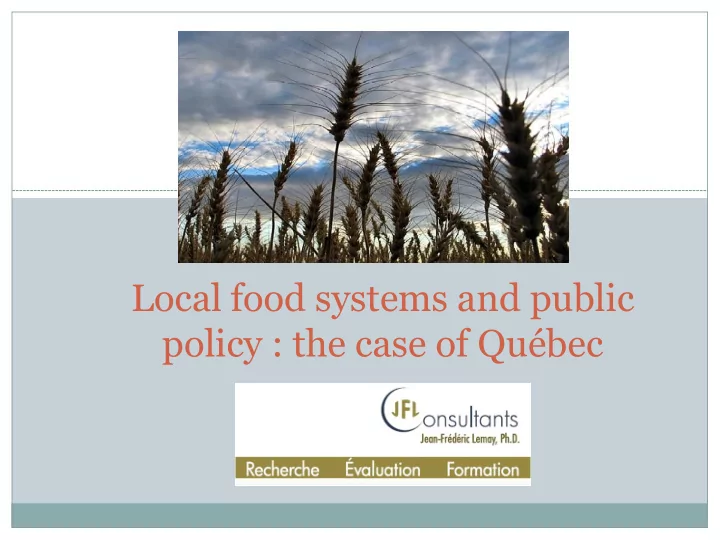

Local food systems and public policy : the case of Québec
The two studies http://www.equiterre.org/publication/local-food- systems-and-public-policy-a-review-of-the-literature- 2009 (Forthcoming) Scaling up local food systems in Quebec and Ontario : actors, institutions, and change in the governance of two regional food systems
Context of Quebec T h i s s h o u l d b e o f p a r t i c u l a r i n t e r e s t t o l o c a l f o o d p r o m o t e r s a s m o s t p o l i c y a r e a s r e l e v a n t t o s h o r t f o o d s u p p l y c h a i n s f a l l e i t h e r e n t i r e l y u n d e r p r o v i n c i a l a n d l o c a l j u r i s d i c t i o n , o r u n d e r j o i n t j u r i s d i c t i o n b u t w h e r e p r o v i n c i a l g o v e r n m e n t h a v e m o r e l e e w a y
The context of Quebec Agriculture, food processing, and retail together account for 6.8% of GDP and 12.5% of all jobs Quebec produces $19.2 billion in fresh and processed food while consuming only $15.4 billion (a 25% surplus) Retailers imported $6.9 billion of fresh and processed foods About 44% of Quebec’s raw and processed food production finds its way onto Quebeckers’ plates, the rest being exported to other Canadian provinces (30%) or overseas (24%)
The Pronovost Commission In 2006, the government of Quebec gave a clear mandate to the Commission : Assess the state and challenges of agriculture in Quebec Analyse the effectiveness of existing public interventions Make a diagnosis Make recommendations based on needs for agricultural competitiveness, social needs and valorization of Quebec’s regions The report was published in 2008 (http://www.caaaq.gouv.qc.ca/)
LFS initiatives and main barriers Lack of financing : Organic and other specialised agriculture 316 certified organic Ex : banks are often not willing to issue livestock production units, 341 organic micro-loans at competitive rates. maple syrup producers, and 585 certified farms (CARTV 2009). Economic power The food retail sector is marked by high Farmers’ markets . network of 82 rates of market concentration open markets, permanent or seasonal, Supermarkets have been able to achieve daily or occasional. economies of scale because they do not have to pay for the social and environmental costs of their business Community-supported practices. agriculture (CSA). Équiterre runs one with over 100 participating farms. Others : Union paysanne (similar Knowledge system) ; La Mauve (Coop CSA), etc. The lack of demand for local foods is attributed to a) a lack of information about Solidarity markets . New where to procure it, b) a lack of phenomenon, solidarity markets are a information about prices. more flexible box scheme. Consumers place an order through a web portal
Examples of barriers/policy/initiatives
Zoning and LFS Z O N I N G L A W S F L E X I B I L I T Y V S P R O T E C T I O N N E W I D E A S
Zoning policy 1978 law on zoning : context of economic development, speculation, fragmentation of the land and non agricultural use. A desire to plan and regulate Loi sur la protection des terres agricoles (LPTAA) Commission de protection du territoire agricole du Québec (CPTAQ) : Quebec’s agricultural zoning agency
The dilemma LFS producers are mostly small and diversified needing small pieces of land (price doesn’t help) The pressure for city expansion, speculation and non agricultural use is still strong How to reform the law without letting the door wide open to what we wanted to prevent from happening in the first place?
New arrangements for land use CAPTQ should be made more flexible to meet LFS needs. In one case, the CPTAQ agreed to allow municipal authorities in Ste-Camille to take over management of a large farm that was for sale in order to help new young families establish small farms. In order to do this, the CPTAQ de-zoned the land, technically empowering municipal authorities to develop it whichever way they want, though there was an understanding that the municipality would keep the land in agriculture. There should be a formal way to make such arrangements without necessarily de-zoning the land and placing it at risk.
Concluding remarks New agricultural policy expected in 2011-12 : based on the Pronovost Commission (hopes) Land use to become a great debate (shale gas, bio-energy, LPTAA reform, young farmers/newcomers, etc.) New initiatives : cooperative land trust, collective buying, Green belts, etc
Recommend
More recommend